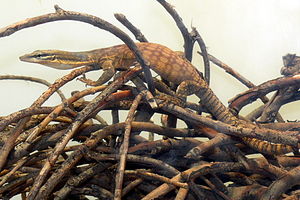Glauert's rock monitor
| Glauert's rock monitor | ||||||||||||
|---|---|---|---|---|---|---|---|---|---|---|---|---|

Glauert's rock monitor ( Varanus glauerti ) |
||||||||||||
| Systematics | ||||||||||||
|
||||||||||||
| Scientific name | ||||||||||||
| Varanus glauerti | ||||||||||||
| Mertens , 1957 |
The Kimberley Rock Monitor or Kimberley Felsenwaran ( Varanus glauerti ), named after Ludwig Glauert , is in Australia endemic representatives from the kind of monitor lizards . He was assigned to the subgenus Odatria . It was first described in 1957 by the German zoologist and herpetologist Robert Mertens .
Appearance, physique
The Glauert rock monitor reaches a total length of 60 to 80 cm, of which the head-trunk length is 22 to 30 cm. This makes it one of the medium-sized monitor lizards from the sub-genus Odatria . The sex of the young can only be recognized by their behavior and growth after six months. The males often grow faster and stronger than the females. After a year or so, the males develop postanal scales at the base of their tails. Compared to the females, the males have slightly wider and more massive heads. The head , body, and limbs are black or dark brown in color. The body is covered with scattered transverse rows of large, bright spots. The pattern of the hind legs consists of transverse rows of small dots. A prominent temporal stripe is visible on both sides of the head. The tail has alternating light and dark transverse bands. The throat and stomach are the only parts of the body that are whitish in color. The scales on the head are smaller, more irregularly arranged and smoother than the rest of the scales. The nostril is located on the side of the head, a little closer to the tip of the snout than to the eye . Around the middle of the body there are 120 to 160 rows of scales. The tail is very round in cross-section, without any sign of a keel on top. The scales at the base of the tail are smooth, whereas those at the tip of the tail are slightly keeled.
distribution
V. glauerti is native to the north of Western Australia and the northwestern part of the Northern Territory . So far only two populations are known. While the animals from the Kimberley region are mainly to be found in rocky surroundings, the animals from the Kakadu National Park are more likely to be tree dwellers.
Way of life
During the mating season , the animals mate several times a day. They lay their eggs 4 weeks after fertilization . The clutch contains an average of 4 to 10 eggs. In captivity at an incubation temperature of 27 to 28.5 ° C, the young hatch after 134-142 days. They are very active animals that never seem to get tired while frolicking around. Their prey consists of insects , arachnids , geckos and skinks , which they prey on their forays through the crevices .
Systematics
The Glauerts rock monitor was described by Robert Mertens (1957) as a subspecies of the Timor monitor ( Varanus timorensis ). Later in 1958, Mertens raised them to species status because he noticed great differences in the scaling between the species.
Web links
- Glauert's rock monitor on iucnredlist.org
- Varanus glauerti in The Reptile Database
- Glauert's rock monitor on monitor-lizards.net
- Glauert's rock monitor on waranwelt.de
- Glauert's rock monitor eats praying mantis on typo.waranforum.de
- Glauert's rock monitor on agamen.nl
Individual evidence
- ↑ Glauert's rock monitor on warane.com
- ↑ Glauert's rock monitor on monster-reptiles.com
- ↑ Glauert's rock monitor on warane.jimdo.com
- ↑ Videos to observe the behavior
- ↑ literature LOSOS & GREENE 1988